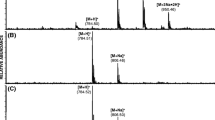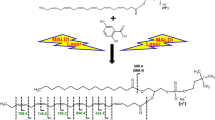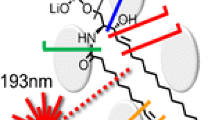Abstract
Structural characterization of phosphatidylinositol (PI), phosphatidylinositol-4-phosphate (PI-4P), and phosphatidylinositol-4,5-bisphosphate (PI-4,5-P2) by collisionally activated dissociation (CAD) tandem mass spectrometry with electrospray ionization is described. In negative ion mode, the major fragmentation pathways under low energy CAD for PI arise from neutral loss of free fatty acid substituents ([M - H - R x CO2H]−) and neutral loss of the corresponding ketenes ([M - H - R ′ x CH=6=C=O]−), followed by consecutive loss of the inositol head group. The intensities of the ions arising from neutral loss of the sn-2 substutient as a free fatty acid ([M - H - R2CO2H]−) or as a ketene ([M - H - R2CH=C=O]−) are greater than those of ions reflecting corresponding losses of the sn-1 substutient. This is consistent with our recent finding that ions reflecting those losses arise from charge-driven processes that occur preferentially at the sn-2 position. These features permit assignment of the position of the fatty acid substituents on the glycerol backbone. Nucleophilic attack of the anionic phosphate onto the C-1 or the C-2 of the glycerol to which the fatty acids attached expels sn-1 (R1CO −2 ) or sn-2 (R2CO −2 ) carboxylate anion, respectively. This pathway is sterically more favorable at sn-2 than at sn-1. However, further dissociations of [M - H - R x CO2H - inositol]−, [M - H -R x CO2H]−, and [M - H - R − x CH=C=O]− precursor ions also yield RxCO −2 T ions, whose abundance are affected by the collision energy applied. Therefore, relative intensities of the RxCO −2 ions in the spectrum do not reflect their positions on the glycerol backbone and determination of their regiospecificities based on their ion intensities is not reliable. The spectra also contain specific ions at m/z 315, 279, 259, 241, and 223, reflecting the inositol head group. The last three ions are also observed in the tandem spectra of the [M - H]− ions of phosphatidylinositol monophosphate (PI-P) and phosphatidylinositol bisphosphate (PI-P2), in addition to the ions at m/z 321 and 303, reflecting the doubly phosphorylated inositol ions. The PI-P2 also contains unique ions at m/z 401 and 383 that reflect the triply phosphorylated inositol ions. The [M - H]− ions of PI-P and PI-P2 undergo fragmentation pathways similar to that of PI upon CAD. However, the doubly charged ([M - 2H]2−) molecular ions undergo fragmentation pathways that are typical of the [M - H]− ions of glycerophosphoethanolamine, which are basic. These results suggest that the further deprotonated gaseous [M - 2H]2− ions of PI-P and PI-P2 are basic precursors.
Similar content being viewed by others
References
Berridge, M. J. Cell signalling. A tale of two messengers. Nature 1993, 365, 388–389.
Ashcroft, S. J. Intracellular second messengers. Adv. Exp. Med. Biol. 1997, 426, 73–80.
Liscovitch, M.; Cantley, L. C. Lipid second messengers. Cell 1994, 77, 329–334.
Quest, A. F.; Ghosh, S.; Xie, W. Q.; Bell, R. M. DAG second messengers: molecular switches and growth control. Adv. Exp. Med. Biol. 1997, 400A, 297–303.
Strum, J. C.; Ghosh, S.; Bell, R. M. Lipid second messengers. A role in cell growth regulation and cell cycle progression. Adv. Exp. Med. Biol. 1997, 407, 421–431.
Jensen, N. J.; Tomer, K. B.; Gross, M. L. FAB MS/MS for phosphatidylinositol, -glycerol, -ethanolamine and other complex phospholipids. Lipids 1987, 22, 480–489.
Murphy, R. C.; Harrison, K. A. Fast atom bombardment mass spectrometry of phospholipids. Mass Spectrom. Rev. 1994, 13, 57–75.
Sherman, W. R.; Ackermann, K. E.; Bateman, R. H.; Green, B. N.; Lewis, I. Mass-analysed ion kinetic energy spectra and B1E-B2 triple sector mass spectrometric analysis of phosphoinositides by fast atom bombardment. Biomed. Mass Spectrom. 1985, 8, 409–413.
Cronholm, T.; Viestam-Rains, M.; Sjovall, J. Decreased content of arachidonoyl species of phosphatidylinositol phosphates in pancreas of rats fed on an ethanol-containing diet. Biochem. J. 1992, 287, 925–928.
Smith, P. B.; Snyder, A. P.; Harden, C. S. Characterization of bacterial phospholipids by electrospray ionization tandem mass spectrometry. Anal. Chem. 1995, 67, 1824–1830.
Kerwin, J. L.; Tuininga, A. R.; Ericsson, L. H. Identification of molecular species of glycerophospholipids and sphingomyelin using electrospray mass spectrometry. J. Lipid Res. 1994, 35, 1102–1114.
Hsu, F. F.; Turk, J. Charge-remote and charge-driven fragmentation processes in diacyl glycerophosphoethanolamine upon low-energy collisional activation. A mechanistic proposal. J. Am. Soc. Mass Spectrom. 2000, 11, 892–899.
Hsu, F. F.; Turk, J. Charge-driven fragmentation processes in diacyl glycerophosphatidic acids upon low-energy collisional activation. A mechanistic proposal. J. Am. Soc. Mass Spectrom. 2000, 11, 797–803.
Author information
Authors and Affiliations
Corresponding author
Rights and permissions
About this article
Cite this article
Hsu, FF., Turk, J. Characterization of phosphatidylinositol, phosphatidylinositol-4-phosphate, and phosphatidylinositol-4,5-bisphosphate by electrospray ionization tandem mass spectrometry: A mechanistic study. J. Am. Soc. Spectrom. 11, 986–999 (2000). https://doi.org/10.1016/S1044-0305(00)00172-0
Received:
Revised:
Accepted:
Issue Date:
DOI: https://doi.org/10.1016/S1044-0305(00)00172-0




